

founded 1996
Llewellin Setter Breed Page


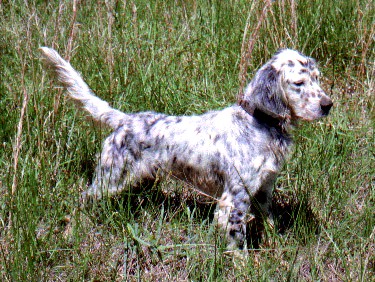 |
Rules set fourth by the National Llewellin Setter Assoc. 'NLSA' and the IPDBA Genetics Board for registration of Llewellin Setters in IPDBA registry.Permanent Registration
Applicant MUST supply the registry with the following minimum requirements for permanent registration in IPDBA.
If already litter registered with IPDBA, just follow instructions provided on filled out and signed IPDBA Blue Puppy Registration form with $15 Registration fee. Add $15 for 5 generation certified pedigree at time of registration.
Transfer Registration
1. Transfers are allowed from another recognized registry, AKC, FDSB, CKC
(Canada), KC (UK) and others recognized by them. Signed and filled out
Setter Transfer Application must include a copy of a 5 generation certified
pedigree and $25. transfer registration fee. Ad $15 to receive an IPDBA
5 generation certified pedigree with registration paper.
2. Provide three (3) clear, color photos of face/front, left side, and right side
of dog.
3. Provide copy of certificate of microchip.
4. Dog must be tattooed with minimum of three tattoo numbers or letters.
(Many use the last three or four digits of microchip number for tattoo in ear.)
5. Five generation certified pedigrees are available at time of registration for
$15. or pay $20. for pedigrees purchased at a later date.
6. A dog's registered name must be made up of three separate words
consisting of no more than 35 letters and spaces total. No duplicate names
or numbers are allowed. Exception for suffix of Jr., II, III, etc. will not
count if space allows.
7. Mandated that when a component of the "Dashing Bondhu" (aka Scinn
Amach, Machad, Cloncurragh and Horsford), is mated with any other
component (bloodline), the offspring cannot carry the name "Dashing
Bondhu" or just "Dashing" or just "Bondhu" as part of its name.
This includes all dogs being transferred.
8. No transfer registration if any "Straight Creek" bloodlines or any dogs owned
or bred by Bob Bailey (aka Bob's Straight Creek Kennel) are in its pedigree or
in its ancestry. All dogs owned, sold, bred, by Bob Bailey are considered to have
questionable pedigrees. If you care about the Llewellin Setter breed, you will
not breed dogs with any of Bob Bailey's Straight Creek dogs in their ancestry. If
you purchase from breeders who do, you will be supporting those who do.
9. No transfer registration of any dogs that the IPDBA Genetics Board has
determined to be a likely carrier of one or more inherited genetic disorders. This
includes all dogs with "Count Gladstone Wind'em D'Hurlain Pre," and/or dogs
with "D'Hurlain" as part of their name in their ancestry. These Wind'em
bloodlines were imported from Belgium from breeder Marie Thérèse à Goës by Keith
Smith of Lynn Hill Kennel. When these dogs were linebred (same ancestry),
they produced deaf, blind, and major hip problems in their offspring. If you care about the
Llewellin Setter breed, you should never breed dogs with any "D'Hurlain"
bloodline in them. Doing so will spread these inherited genetic disorders
throughout the breed and eventually all dogs within the breed will be
carriers and will all produce them. If you purchase from breeders who do,
you will be supporting those who do.
10. All registrations are issued with the right to correct or revoke reserved by IPDBA.
New Kennel Special 50% Off
(Limited time offer for 1st time kennel transfers)Dual register your whole kennel with IPDBA and SAVE!
Transfer up to 5 dogs or litter registrations from another registry and your Life-Time Kennel name registration for only $125.00 Total ($125.00 Savings)
Each additional dog or litter sent in with the above is just $10.00 each.
Five generation pedigrees are available for each dog for just an additional $10.00 each when sent in with above paperwork.
Litter Registration
All Litters must be registered. Applicant must supply the following for each litter registration.
1. IPDBA Setter Litter Application must be filled out and signed by both the owner of sire and
the owner of dam. Submit IPDBA litter application with $15 registration fee.
2. Dam must be registered with IPDBA before or at time of litter application and must
meet all permanent registration requirements.
3. If sire is not IPDBA registered and is not going to be IPDBA registered, a copy of his
registration papers and 5 generation certified pedigree must be provided with every
litter he sires.
FDSB Bloodlines Banned from IPDBA Registration!
4. No Litter Registration if either parent has any "Straight Creek" bloodlines or
any dogs owned or bred by Bob Bailey (aka Bob's Straight Creek Kennel) are in
its pedigree or in its ancestry. All dogs owned, sold, or bred by Bob Bailey are
considered to have false pedigrees. If you care about the Llewellin Setter
breed, you will not breed dogs with any of Bob Bailey's Straight Creek dogs
in their ancestry.
5. No litter registration if either parent has any dogs in their ancestry that the
IPDBA Genetics Board has determined to be a likely carrier of one or more
inherited genetic disorders. This includes all pedigrees with "Count Gladstone
Wind'em D'Hurlain Pre", and/or all dogs with "D'Hurlain" as part of their
name, Wind'em bloodlines imported from Belgium by Keith Smith of Lynn
Hill Kennel. When these dogs were linebred (same ancestry), they produced
deaf, blind, and pups with major hip problems. If you care about the Llewellin
Setter breed, you should never breed dogs with "D'Hurlain" bloodline in
them. Doing so will spread these genetic disorders throughout the breed and
eventually all dogs within the breed will likely become carriers and will
all produce them.
Recommendations to breeders
Please tattoo and microchip each pup before placing them in their new homes. It is very difficult and expensive for individual owners to get their pups/dogs tattooed and/or microchipped and protects you from the buyer switching pups and/or making false accusations about the pup not being the correct pup.
The ideal and most reasonable tattoo equipment available for tattooing small pups that will remain readable when they are adults is available at www.bassequipment.com . We recommend using green ink (roll-on or paste) and tattooing them with three digits at 5 weeks or older (most breeders tattoo the last three digits of the microchip number).
We also recommend microchipping every pup before placing them. We recommend the Mini-Pro ID Microchips (smallest microchip) available direct wholesale from Microchip ID Systems at www.microchipidsystems.com and are automatically registered to you, the breeder, and you can contact a person if the pup is lost and found. Buyers can easily register the chip in their name online for only a one time fee of $24.95.
If you purchased a Setter pup without a tattoo or microchip or are transferring a Setter to IPDBA, it is actually cheaper to purchase the tattoo 0-9 numbers, ink, and a microchip yourself using the above companies, rather than have your Vet do them.
IPDBA Genetics Board recommends linebreeding (family breeding) your dogs rather than outcrossing (totally unrelated) dogs within the breed. Line and inbreeding is natures proven way to remove mutations that do not benefit their species. Linebreeding will assure no outside genetic recessives will be added to your breeding program while outcrossing can introduce and hide many inherited genetic disorders for many generations until many dogs within the breed and your kennel will become carriers. Many popular dog breeds today are close to extinction because of a 30-40 year fad of outcrossing and many can no longer produce a healthy litter of pups today. Linebreeding does NOT cause genetic mutations, it will only produce pups with genetic problems "IF" one or both of the parents are carriers of the problem (genetic mutations). Through linebreeding, any new mutations problems can be removed from your breeding program quickly, saving your breeding program and the whole breed from any genetic mutations. Line or inbreeding does not cause mutations, mutations naturally happen in all living creatures and only through line or inbreeding can they be recognized and removed quickly. Canine geneticist have found that mutations are in 5% of all canines tested. Outcrossing will hide and multiply these mutations until it has spread throughout your breeding program and throughout the whole breed resulting in the major problems that most owner's will not want to deal with, resulting in a dying breed.
IPDBA Rules for Breeding Llewellin Setters
NO Allowable Breed Out-crosses:
1. Only a "Llewellin Setter" bred with "Llewellin Setter" will result in "Llewellin
Setter"offspring in IPDBA.
2. A "Llewellin Setter" bred with a "Russian Llewellin Setter" will result in "Russian
Llewellin Setter" offspring.
3. A "Llewellin Setter" bred with an "English Setter" will result in "English Setter"
offspring.
Llewellin Setter Description(How a Llewellin Setter should look)
That being said, everyone likes a good looking dog and everyone wants their dogs to look like their respective breed. When it comes to a dogs looks, regardless of their breed, there are different opinions on what they should look like. In most breeds the few members of an elected breed committee draw up a Breed Standard and the membership vote and the majority wins. The problem with this system is that only a few are involved in the writing of the Breed Standard it self and are usually by people who only show their dogs. Instead of making an ideal standard of what an ideal goal of the breed should look like, it is most likely written to be shown so they can win titles, resulting in dogs that fall far short from an ideal of a hunting or even a companion dog.
Unfortunately, people who show are usually not the same people who hunt. Heck, even those hunt for pleasure seldom enter a field trail and is why field trial type dogs are usually not suited for the average pleasure hunter and visa-versa. It is very tempting to purchase a pup from Field Champion or Show Champion pedigree, but can be the worst thing a pleasure hunter could do.
So as long as their are shows, field trails and pleasure hunters, their will always be THREE types of dogs developed. This is why IPDBA has "Gun Dog Certification", because the inspection just looks for four natural qualities, #1 Hunt (search for birds) #2 Point (solid on bird scent), #3 Retrieve (shot bird to hand), and #4 Backing (honor another pointing dog). No emphases on how long it takes, how wide the dog hunts, how the dog looks, the breed of the dog, or who owns the dog, just the four fundamentals of a good pleasure hunting gun dog and companion.
OK, let us get back to the description or looks of the Llewellin Setter. Fortunately, good hunting dogs usually mean good genetic form, or what makes a good physical hunting dog, like straight legs, tight toes, light footed, big chest, straight back, big muzzle, medium coats, strong hind quarters, etc..
The Llewellin Setter puppy is predominantly white at birth. As the cute fuzzy ‘puppy coat’ of a Llewellin Setter pup sheds they will soon develop small colored spots (called ticking which is indicated as Ticked, abbreviated Tkd). The ticking will be the same color as the major patches, such as Black, Orange/Tan, or Chestnut (liver) all over their body. The ticking color will sometimes vary a lot on different parts of the body and is always more distinct and sometimes appears darker on the extremities of the Llewellin Setter.
You will notice that the ticking on the litter diagrams is indicated at varying degrees of intensity. The mature amount of ticking on the body of a Llewellin cannot be determined with certainty at birth. At the time the Llewellin Setter pup is 5 to 6 weeks old the ticking begins to show clearly on the belly, legs, nose and ears. When a Llewellin pup is between 3 & 6 months old, it will begin to reach its full coloration. The degree of ticking indicated on the charts is an educated guess based on the amount of ticking on the skin of the belly of the pup and the parents.
[1] BASIC COLORATION OF THE LLEWELLIN SETTER
Dominant color is always listed first in the color classifications with the lesser color listed second and so on.
White, Black, & Ticked -- White, Orange/Tan, & Ticked -- White, Chestnut, & Ticked
Rarely the coloration can be listed as Black, White, & Ticked – Orange/Tan, White, & Ticked – Chestnut, White, & Ticked!
Again all large markings will show up on the pup at the time of birth.
[2] White, Black, & Ticked: The most common color with solid Black Markings and Black ticking,
no tan markings or ticking..
Example: Differences between a Tri-Color and White, Black, & Ticked with similar markings.
[3] TRI-COLORATION: Basically, they have the same pattern as their cousin the Gordon Setter with Orange/Tan spot over each eye and Orange/Tan on muzzle, cheeks, feet, under ears, belly and their under parts. See examples below....
Tri-Coloration
Note: how the Tan/Orange appears in the same location on a
Tri-Color Setter as it does on the Gordon Setter.
Examples of Gordon Setters
Examples of Tri-Coloration
Gordon Setter
Tri-Color
Gordon Setter
Tri-Color
Gordon Setter
Tri-Color
Gordon Setter
Tri-Color
TRI-COLOR LLEWELLIN SETTERSAgain dominant color is always listed first in the color classifications with the lesser color listed second; while the TRI-COLORS have a third color.
TRI-COLORED Llewellins are not common in some lines, but are very common in the Dashing Bondhu line!
TRI-COLOR term is used on pups that are a combination of White, Black, TAN (Orange) and Ticked.
Rarely a Tri-Color will be White, Chestnut, Tan (Orange) and Ticked and are listed as TRI-CHESTNUT.
Quad-Color: Has not been genetically proven to be a possible color combination as Tan and Orange are the same gene and a dog cannot have Chestnut and Black because the dilute gene that makes the Black appear as a Chestnut in color would have to be present changing all the Black on the dog to Chestnut.
The same goes with Lemon as to get Lemon, you must have the Orange/Tan gene and a dilute gene present that makes it appear Lemon. You cannot have Orange and Lemon on the same dog. You can have different shades of the same color, but lighter color on the ears or different parts of the body does not constitute a different color.
It is virtually genetically impossible to produce a Setter with 4 or 5 different colors. Shads of the same color are common, but not different genetically.
Bottom line, if you think you see more than 3 colors on your Llewellin Setter, it may not be genetically possible and be registered as a Tri-Color, but you still have a beautiful Setter that appears to have more than three colors to the eye.
Until proven genetically possible, IPDBA will not recognize more than three colors on a Llewellin Setter. They will be registered as Tri-color, Tri-Belton, Tri-Chestnut, or as Tri-Chestnut Belton.
The Red Irish Setters are perfect examples of how the same color can appear differently on different areas of a Setters body. This is the same effect seen on Tri and other Llewellin Setters that appear to have different colors like orange, tan, chestnut, blue, etc..
Note: Lighter shade of red on ears, chest, and feet.
Note: Lighter shade of red on ears chest, & under parts. Also note, darker body coloration, appearing to be Chestnut in color.
Note: Lighter shade of red on top of head, ears & chest.
Note: Lighter shade of red on ears, under parts and tail.
[3] BELTON LLEWELLIN SETTERS: A TRUE BELTON IS BORN SOLID WHITE. Many confuse the term Belton incorrectly with the term Ticking. So some English Setters have been called all Setters a Belton, even if they have body markings, but any Setter with markings is NOT a Belton.Some Llewellin Setter pups are born solid WHITE! As they mature they will NOT have major body patches of color, only ticking. These are recognized as a Belton.
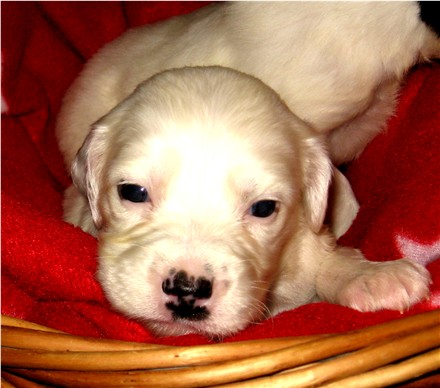
True Tri-Belton pup at 3 wks
(born all white and still all white)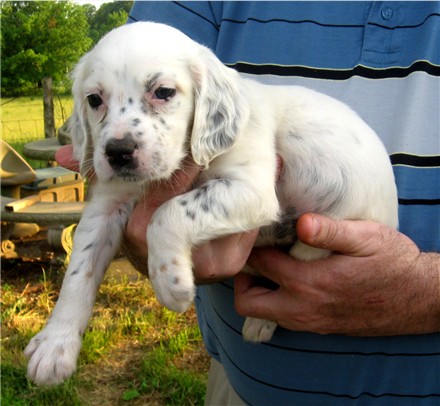
Same Tri-Belton pup at 6 wks old
(has faint ticking on body, but showing ticking on belly, legs, ears, and muzzle)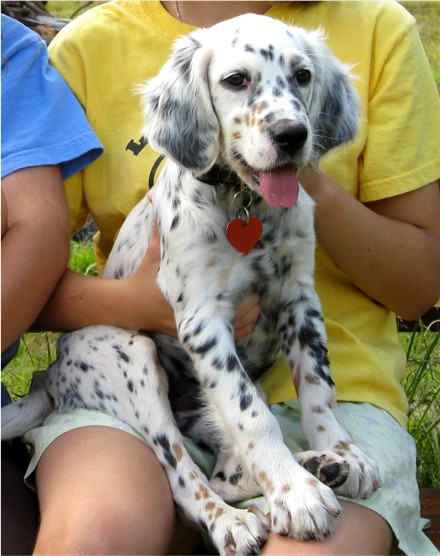
Same Tri-Belton pup at 3 months old
(Tri-Belton is 3/4 ticked)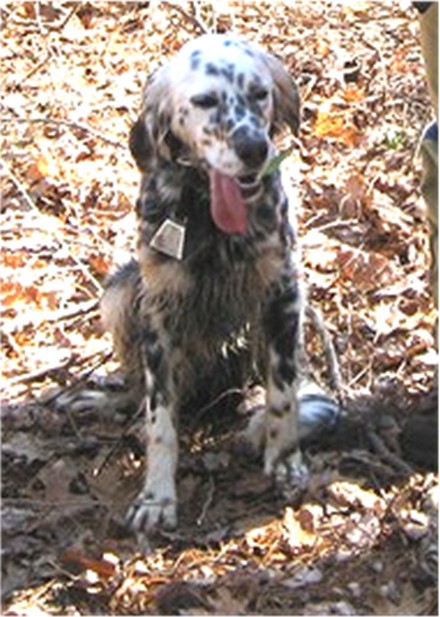
Same Tri-Belton pup at 12 months old
(Tri-Belton is fully ticked now)
Amount of Ticking will vari from pup to pup.
They will only end up marked with a number of small spots or ticking and are called BELTONS: Orange Belton, Chestnut Belton, or Blue Belton which are actually Black Beltons, but their ticking appears Blue because of the overlay of White hair over their ticking. This will also make an Orange Belton appear to have Tan Ticking and a Chestnut Belton sometimes appear as a Red-Belton if enough ticking is present.
Some Beltons will be Tri-BELTONS or TRI- Chestnut BELTONS!Tri-Beltons are the same as a Blue Belton but develop Orange/Tan ticking around the muzzle and on the paws, etc., like the Tri-color. This can vary so much from just one tick on each paw and muzzle, so that they are not seen until adults, to heavy ticking half the way up their legs making it very easy to tell they are Tri's at an early age. The amount and shading will vary, depending on the area of the body and length of hair.
TRI- Chestnut Beltons likewise develop Orange/Tan ticking around the muzzle and on the paws and the amount and shading will vary, depending on the area of the body and length of hair.
Just like with all Llewellin Setter colors, a Belton's ticking may be lightly, moderately or heavily ticked.
In the Llewellin Setter the Belton ticking is the same type of spotting as the spots of color on a Dalmatian, the difference is in the long coat of hair on the Llewellin body. Rarely this ticking does not tend to mingle with the surrounding white coat and in such case the distinct dots of Dalmatian type ticking is striking. In the Llewellin the eventual coloring description on these white Belton pups is impossible to determine until around 5 to 6 weeks of age.
The degree or amount of ticking of an individual Llewellin pup can only be estimated by the amount of ticking on the skin of the belly and the actual amount of ticking could take 6 months to fully show.
The mating of two Llewellin Setter dogs of like coloration is not an absolute in determining the coloring of their offspring.
The Orange/Tan gene coloration is present in most Llewellin Setters. It can be carried both as a dominant or as a recessive.
The presence of the Orange/Tan coloring possibility is what makes the range and variety of coloring possible within each litter of the Llewellin Setter.
Only 100% Pure Llewellin Setters are Registered with IPDBA
(International Progressive Dog Breeders Alliance)
IPDBA has not had ANY dogs with DNA problems, nor has registered a ANY dogs who have in other registries. IPDBA has permanently banned ANY and ALL questionable dogs and ALL their offspring from their registry. Many of these are still being bred in FDSB, NSTRA, UKC, and AKC.
The sex has nothing to do with the hunting ability or quality of bird dog they will make, especially with the Dashing Bondhu strain. Size may very between different bloodlines. The males are usually more handsome and average 5 to 10 pounds more than females and ultimately size may have a lot to do with personal choice. The choice of sex is just a matter of personal preference with the Dashing Bondhu bloodline.
Gun Dog Certification
The International Progressive Dog Breeders’ Alliance has set up a Gun Dog Certification system for various sporting dog breeds. The owner must supply a video of the dog meeting the following requirements with a copy of the dog's IPDBA registration papers to the IPDBA office for inspection with the $30 non-refundable inspection fee. You can email videos and pay fees through Paypal to ipdba-registry@gmail.com
Pointing Breed Requirements:
Basic requirements are searching, pointing, retrieving without other dogs, and then backing (honoring another pointing dog).
Video footage must show:
1. The dog by itself coursing (working the field) in search of live game birds without
other dogs.
2. Dog must then locate live game birds by pointing and holding point on their own
until birds are flushed by handler or hunter.
3. The video must also show handler or a hunter shooting at least one game bird over the
same dog by itself and the same dog retrieving the fallen game bird to handler or
hunter's “hand” (drops will not pass inspection unless dog picks up bird and delivers
it to the hand without any aid from handler or hunter). Dog may be called during
retrieve.
4. The video must also show footage of the same dog backing (honoring point) another
pointing dog or a silhouette cutout of a dog pointing for a minimum of 1 minute.
5. These actions may be recorded consecutively or separately in sections of the video, but
each requirement must be clearly shown at least one time in a section of video and no
section may be edited.
Dog must NOT be wearing any electrical training devices like electronic shock, tracking, or beeping collars and must not have any restraints such as leashes or check cords on them while in the field; only a regular dog collar with name plate or tag is allowed.
No other dogs may be in the field while dog is shown searching, pointing or retrieving, and only one other dog may be in the field while showing the dog backing (honoring point).
If approved, a Certificate of Accomplishment will be sent to the dog's owner and the dog will receive the title of Gun Dog Certified and title letters ‘GDC’ will be added to the IPDBA database in front of the dog's name and the GDC title will be recorded on all future pedigrees with their name highlighted in red.
Please note that VHS/DVD sent to IPDBA will not be returned and all video footage and copyrights will become the property of IPDBA. Video will be kept for proof of Gun Dog Certification, and IPDBA will have all rights to show, sell, advertise, use, or profit from the complete or portions of the video without compensation to the applicant, photographer, or owner.
Dogs may also be inspected by an approved IPDBA inspector. An inspector may not inspect his own dogs or dogs he or she is the breeder of or are owned by friends, family members, or business associates.
IPDBA has the right to reject any application and approve or disapprove an inspector at time of application.
IPDBA may accept a Gun Dog Certification awarded by certain approved inspectors, trainers, organizations, or registries. Email IPDBA for approval before sending application. To receive IPDBA Gun Dog Certification, an application for IPDBA GDC must be sent with a copy of the prior approved Gun Dog Certification certificate with $25. fee to IPDBA. On approval, an IPDBA Gun Dog Certificate will be sent to the owner and the dog will receive GDC title. GDC title will be added to dog's name on all future registrations and pedigrees.
Please Note: even if a dog is Gun Dog Certified by an inspector, trainer, other organization or registry, it does not mean the dog is "IPDBA GDC". They MUST have received an "IPDBA Certificate of Gun Dog Certification" to be an IPDBA GDC and receive the title. The IPDBA GDC Logo may ONLY be used by breeders and kennels who have "IPDBA" GDC-titled dogs. It will be considered "FALSE ADVERTISING" by IPDBA Ethics Board if the IPDBA GDC logo is used on websites without official IPDBA GDC titled dogs and should only be used on them.
IPDBA Llewellin Setter
Breeder/Kennel Listing
IPDBA accepts breeders/kennels for this listing in good faith and who are in good standing. IPDBA accepts no responsibility for any unethical sales or dealings or for the health of the puppy or dog purchase. Any complaints should be filed with the breed's charter association. Kennels listed are all in good standing with IPDBA. Kennels are listed in alphabetical order.
This is a free listing for breeders/kennels who breed IPDBA registered Llewellin Setters ONLY. Listed kennels must not be selling or have links to any dogs not registered with IPDBA. If your kennel raises only IPDBA registered Llewellin Setters and would like to be listed and linked, please contact IPDBA. Please note: this is not a complete list of all IPDBA breeders/kennels raising IPDBA Llewellin Setters.
Last names listed in alphabetical order.
IPDBA Breeder Awards
Master Breeder
Michael J. Bloodgood
Alfred O. King Sr.
Grand Master Breeder
Michael J. Bloodgood
Alfred O. King Sr.
Supreme Grand Master Breeder
Michael J. Bloodgood
Alfred O. King Sr.
Honorary Life-Time Breeder Award
Michael J. Bloodgood
Alfred O. King Sr.
IPDBA Llewellin Setter
The IPDBA Board of Directors have voted the following Llewellin Setters into their Breeds Hall of Fame. Hall of Fame
Hall of Fame GDC IrishKing Bondhu Ashly
(Machad Ambassador X Bickers Bondhu Ann)
Bred by Dr. E. E. Bickers, & Owned by Alfred O. King
Hall of Fame GDC Henry PrinceOf Pause aka 'Hank'
(H/F GDC IrishKing Bondhu Ashly X Dashing Janette Bondhu)
Bred by Alfred O. King & Owned by Dez Young
Hall of Fame GDC Hank's Dashing Bondhu, aka 'Dash'
(H/F GDC Henry PrincOf Pause X Dashing Miss Bondhu)
Bred by Alfred O. King & Owned by Dez Young
Hall of Fame GDC Hank's Ringo Bondhu
(H/F GDC Henry PrinceOf Pause X Dashing Chess Bondhu)
Bred & Owned by Alfred O. King
Llewellin Setter
Registration Forms
Please click on star to follow URL
Setter Transfer Registration
Setter Litter Registration
Kennel Registration
Confirmation or Transfer of Titles
Please click on star to follow URL
Disclaimer Copyright © 1996 - 2024
Property of the International Progressive Dog Breeders' Alliance (IPDBA) and may not be copied, reproduced, or reprinted without written authorization.
® All Rights Reserved